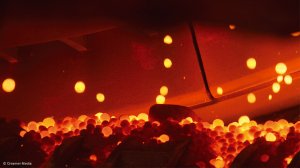JOHANNESBURG (miningweekly.com) – The Save SA Smelters movement, which has thrown its full weight behind the decision of the Cabinet to impose an export tax on raw chrome leaving the country, on Friday responded to the analysis of ChromeSA that the imposition of such a tax would be high risk.
ChromeSA was formed late last year after the Cabinet announced that a chrome export tax was in the offing, but the tax has not yet been implemented.
South Africa has installed capacity to produce 5.6-million tonnes of ferrochrome a year but is currently producing only about 3.6-million tonnes.
Most of the chrome ore China uses to produce ferrochrome in competition with South Africa is sourced from South Africa itself.
“It is with great sadness that we note the recent article stating that the imposition of a chrome export tax would be high risk,” Save SA Smelters secretary Billy Mankgane stated in a release to Mining Weekly, in which he reiterated his movement’s call for the implementation of the tax to support the ferrochrome industry, which adds value to raw chrome prior to its export.
South Africa's once almighty ferrochrome industry has been struggling to make ends meet and has closed a number of its electricity-intensive smelters as a result. It has lost considerable market share as a consequence of the growing volumes of the export of South African-mined chrome ore, and has been battling to remain competitive in the face of Eskom's high electricity tariffs.
“As Save SA Smelters, we once again acknowledge that the increase in electricity costs is an important issue and we have never shied away from this fact,” said Mankgane.
In an attempt to help itself, the ferrochrome industry is looking to lowering its onerous electricity costs by potentially generating 750 MW of its own energy, made up of a mixture of on-site generation using offgas and Stirling engines or various types of equipment, possibly off-site wind and solar power, as well as virtual power purchase agreements involving renewable energy being wheeled on the national electricity grid.
“Here is our concern," said Mankgane. "ChromeSA also happens to be an organisation whose members are predominantly platinum producers.” This is a reference to ChromeSA's platinum group metals (PGMs) member companies producing chrome as a byproduct of their mining of upper group two (UG2) reef in pursuit of PGMs. UG2 reef is a particular target currently as it is weighted towards palladium and rhodium, the prices of which have gone through the roof. Those two PGMs in particular have enabled PGM-mining companies to report record results in recent months and pay excellent dividends to shareholders. Although the export of raw chrome in these circumstances does not add greatly to the fortunes of PGM companies, it negatively impacts the South African ferrochrome business significantly by supplying UG2-linked byproduct chrome ore to its global competitors
“The UG2 producers will produce UG2 as a byproduct with or without a tax as it is a necessary step in the production of PGMs,” Mankgane wrote in the Save the SA Smelters release. “The byproduct comes literally for free,” he said, adding that the UG2-linked chrome price is less than R1 600/t free on board (fob) while the ferrochrome price is close to R23 000/t fob, or 1 400% higher in value.
“Why are we allowing this low value, low contribution material to be dumped in China, along with precious South African jobs?” Mankgane asked.
“Save SA Smelters is merely advocating for the implementation of South African policies which are meant to benefit our people here in South Africa,” Mankgane added.
As Mining Weekly has reported, five of South Africa’s ferrochrome smelters have either been shut down, liquidated or placed in business rescue. These smelters supported more than 31 000 jobs along with a yearly contribution of R11-billion to South Africa’s gross domestic product (GDP).
Direct employment lost in the past five years totals 1 139 jobs. Another 1 608 jobs are currently at risk under Section 189 of the Labour Relations Act, and remaining at risk are another 5 243 jobs.
Also supporting the imposition of a tax on the export of chrome ore as intensely as the placard-bearing Save SA Smelters movement are:
- South Africa’s ferrochrome producing companies, which consume 8.2-million tonnes of chrome ore a year, employ 6 851 people directly, support 68 000 jobs overall, contribute R41-billion to South Africa’s GDP, pay R14-billion a year to Eskom, have pay-as-you-earn tax payments of R1.4-billion, buy 2.5-million tonnes of product a year from 20 South African reductant mines, and accord R42-million a year in social support and local enterprise development;
- The 1 177-employee Tendele Coal Mining, along with another five South African anthracite producers, which collectively provide jobs for another 3 800 employees; and
- The 1 500-employee Columbus Stainless of Mpumalanga, which produces stainless steel locally from the locally produced ferrochrome.
Columbus Stainless is a member of the Spanish-based Acerinox and the only fully integrated, single-site stainless steel producer in Africa. The plant – based in Middelburg – produces austenitic, ferritic, utility ferritic –3CR12® – and duplex grades of stainless steel suitable for most applications.
Chrome ore imports into China increased from 6.1-million tonnes for the first five months of 2020 to 6.5-million tonnes for the first five months of 2021 and South Africa accounted for 86% of the chrome ore imports.
Global stainless steel producers have reportedly scrambled to import more chrome-containing UG2-concentrate from South African PGM-mining companies, as well as chromite ore from Zimbabwe, to smelt in China, with a small volume also smelted in Zimbabwe itself.
EMAIL THIS ARTICLE SAVE THIS ARTICLE ARTICLE ENQUIRY
To subscribe email subscriptions@creamermedia.co.za or click here
To advertise email advertising@creamermedia.co.za or click here













